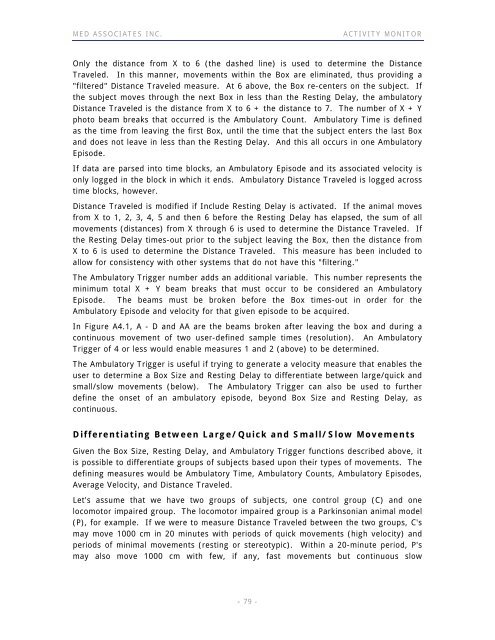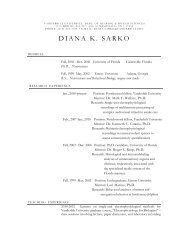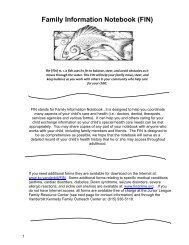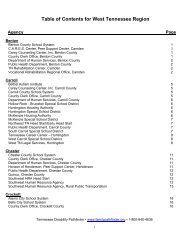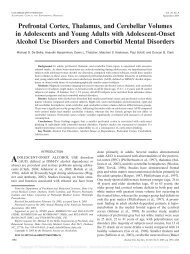ACTIVITY MONITOR - Vanderbilt Kennedy Center
ACTIVITY MONITOR - Vanderbilt Kennedy Center
ACTIVITY MONITOR - Vanderbilt Kennedy Center
You also want an ePaper? Increase the reach of your titles
YUMPU automatically turns print PDFs into web optimized ePapers that Google loves.
MED ASSOCIATES INC. <strong>ACTIVITY</strong> <strong>MONITOR</strong><br />
Only the distance from X to 6 (the dashed line) is used to determine the Distance<br />
Traveled. In this manner, movements within the Box are eliminated, thus providing a<br />
"filtered" Distance Traveled measure. At 6 above, the Box re-centers on the subject. If<br />
the subject moves through the next Box in less than the Resting Delay, the ambulatory<br />
Distance Traveled is the distance from X to 6 + the distance to 7. The number of X + Y<br />
photo beam breaks that occurred is the Ambulatory Count. Ambulatory Time is defined<br />
as the time from leaving the first Box, until the time that the subject enters the last Box<br />
and does not leave in less than the Resting Delay. And this all occurs in one Ambulatory<br />
Episode.<br />
If data are parsed into time blocks, an Ambulatory Episode and its associated velocity is<br />
only logged in the block in which it ends. Ambulatory Distance Traveled is logged across<br />
time blocks, however.<br />
Distance Traveled is modified if Include Resting Delay is activated. If the animal moves<br />
from X to 1, 2, 3, 4, 5 and then 6 before the Resting Delay has elapsed, the sum of all<br />
movements (distances) from X through 6 is used to determine the Distance Traveled. If<br />
the Resting Delay times-out prior to the subject leaving the Box, then the distance from<br />
X to 6 is used to determine the Distance Traveled. This measure has been included to<br />
allow for consistency with other systems that do not have this "filtering."<br />
The Ambulatory Trigger number adds an additional variable. This number represents the<br />
minimum total X + Y beam breaks that must occur to be considered an Ambulatory<br />
Episode. The beams must be broken before the Box times-out in order for the<br />
Ambulatory Episode and velocity for that given episode to be acquired.<br />
In Figure A4.1, A - D and AA are the beams broken after leaving the box and during a<br />
continuous movement of two user-defined sample times (resolution). An Ambulatory<br />
Trigger of 4 or less would enable measures 1 and 2 (above) to be determined.<br />
The Ambulatory Trigger is useful if trying to generate a velocity measure that enables the<br />
user to determine a Box Size and Resting Delay to differentiate between large/quick and<br />
small/slow movements (below). The Ambulatory Trigger can also be used to further<br />
define the onset of an ambulatory episode, beyond Box Size and Resting Delay, as<br />
continuous.<br />
Differentiating Between Large/Quick and Small/Slow Movements<br />
Given the Box Size, Resting Delay, and Ambulatory Trigger functions described above, it<br />
is possible to differentiate groups of subjects based upon their types of movements. The<br />
defining measures would be Ambulatory Time, Ambulatory Counts, Ambulatory Episodes,<br />
Average Velocity, and Distance Traveled.<br />
Let's assume that we have two groups of subjects, one control group (C) and one<br />
locomotor impaired group. The locomotor impaired group is a Parkinsonian animal model<br />
(P), for example. If we were to measure Distance Traveled between the two groups, C's<br />
may move 1000 cm in 20 minutes with periods of quick movements (high velocity) and<br />
periods of minimal movements (resting or stereotypic). Within a 20-minute period, P's<br />
may also move 1000 cm with few, if any, fast movements but continuous slow<br />
- 79 -


